Alexander Hellene's Blog
April 22, 2021
For the Birds

When my brother and I were kids, we used to birdwatch with our grandmother. The backyard at our grandparents’ house was at a lower level than the front, so our grandfather put up a really tall, two-story pole with a bird feeder attached right in front of the huge double-windows in the small sitting area near their kitchen. Squirrels used to somehow make it up there despite my grandfather’s best efforts, but not enough to scare the bird away. There was also an absolutely massive tree, I think it was an oak, that birds used to congregate on.
This was when our sister was a baby who didn’t accompany us on our trips to Yiayia and Papou’s until she was older. So it was my brother, my grandmother, and me watching birds during lunch, or just as a break from playing, when Papou was out doing errands.
She had an old Adubon guide that she’d encourage us to look up birds in. We’d laugh at some of the names–the tufted titmouse, the blue-footed booby, har har har–but my brother and I knew them. The goldfinch was a favorite as were, of course, the male cardinals and blue jays.
I lost the birdwatching bug not too long after that, and while I later learned the word “ornithology,” both as a science and a Charlie Parker song, I never actually participated in this grand and noble art as a teenager or young adult. Yet the fond memories of sitting with Yiayia, keeping track of what we saw, and laughing at Papou’s attempts to keep “those GOD DAMNED squirrels” off the feeder remained.
I am going to be forty later this year. Coincidentally, or maybe not, I’ve also developed a fondness for birds and birdwatching this spring. I’ve been spending more time at home, and that means spending more time looking out the window. Thankfully, the birdfeeders we have attract quite a few flying visitors.
There are hummingbirds, of course. I’ve always liked them. There are more cardinals and blue jays here in central Massachusetts than I remember seeing in coastal New Hampshire, though nowhere near as many goldfinches. There are other types of finches, though, including purple finches. And the tufted titmouse is a regular visitor–what a cool-looking bird.

We’ve even bought two parakeets, one of whom actually seems to like it when I take him out of the cage to hold him.
For whatever reason, I find myself drawn to birds. I think I’m jealous of them. Here I am, this supposedly “highly evolved” being, and I can’t just take off and fly whenever I want the way these tiny little creatures can. And sing . . . I’d give almost anything to have an effortlessly beautiful voice like these birds do.
None of this admiration applies to chickens, though. Or ostriches. Or any other type of stupid-looking, flightless fowl. I’m talking awesome birds, birds like the eagle and the hawk all the way to the hummingbird and the mourning dove.
Food? Whatever seeds, fruits, worms, or bugs they can find. And bugs are everywhere. No wonder the birds never go hungry.
The beauty and the freedom, even the cute way so many mate for life, are very endearing. We have the expression “lovebirds” for a reason.
We also have the expression “birdbrain” for a reason, too, but maybe ignorance is bliss, you know?
Behold the fowls of the air: for they sow not, neither do they reap, nor gather into barns; yet your heavenly Father feedeth them. Are ye not much better than they?
— Matthew 6:26
Sometimes I’m not all that sure I’m much better than them, actually.
…
For the record, the idea that birds are reptiles is preposterous.
No birds, but plenty of freaky aliens.
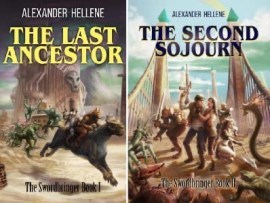
April 20, 2021
Crusader Mindset

David V. Stewart and Brian Neimeier have been writing really good pieces lately on the failures of all American political schools of thought that are caught in the typical left/right, Democrat/Republican paradigm. This paradigm doesn’t work because, as both men have shown, they are just two different flavors of liberalism: American conservatism, what passes for “right-wing” political thought in the United States, is nothing more than market-worshipping hedonism under the guise of “freedom” (to do what?) and the idea that if something makes money, it’s positive, and screw any idea of the “greater good.” These people often also call themselves Christians, which is weird, but anyway.
The American left takes these ideas and gussies them up with moral arguments based on an explicitly anti-Christian secular ethos that still sometimes retains a patina of Christinaity to have a little moral gloss that can fool those recalcitrant to go along with their insane ideas. The American left has the same conception of “freedom” as the American right; it’s just the high-cal version with real ingredients being served up now instead of the one made with oil-based substitutes that’ll be on the conservatives’ menu five years from now. Being good materialists, the left is just as avaricious as the right–they just have the decency to at least lie about it. Because unlike with the American right, the American left is on a moral crusade. It’s a religion.
This brings us to an important point, yet another example of why the American right always loses: Unless you have a moral reason for why a thing is good or a thing is bad, your arguments will always fail in the face of a movement that does.
You can make all the economic arguments you want for why thing A is good and thing B is bad, but that reduces the American citizenry to just numbers on a spreadsheet. “On balance, doing this makes the GDP move up a fraction of a percent, and while its effects on society and civic culture are disastrous, the ‘greater good’ isn’t our concern.” “We just can’t do this thing that’ll help people! It’s against the free market and our conservative principles!”
That’s never as effective as “Doing this is good, and opposing it is evil. We are good, and they are evil because of this.”
Christianity used to be the countervailing opposition to the progressive religion. It was replaced–with the consent of the nominal American opposition!–with economics. To fight Moloch, Jesus was jettisoned and the American right drafted Mammon. It’s no wonder they always lose. And you know what? They deserve to.
I must clarify that the historical and widely accepted teachings of Jesus as understood by the Church for the first thousand years of church history, and still maintained by the Orthodox and Catholic Churches, was jettisoned for some weird money-hungry prosperity gospel ahistorical and quite frankly heretics type of Christ who supposedly wants us to be rich and fight wars to free people over there while our own freedoms, including the freedom to worship, are curtailed and His name continually blasphemed over here, but I digress.
Just as bad, if I may digress further, is the leftist version of a weird, pan-region Christ who just, like, taught to be a good person, man, and was just a great moral teacher, bro.

Fight fire with fire. Fight faith with faith. We’re not voting our way out of this, and we’re not reasoning our way out of this either. Feelings don’t care about your facts.
Why is something good or bad? Because God said so. That’s it, ends of story, full stop. That has to be the answer. This will galvanize people more than “Because an accountant said corporate tax cuts will trickle down to help the poor. Now pass my weed.”
Don’t like it? Don’t want “church and state intertwined”? Well guess what–you already have it. It’s just not the type of church you’re expecting. You know, the one that can build a lasting civilization instead of destroying it.
Nobody enjoys living in a declining, atomized economic zone with a steadily declining standard of living. People want to be a part of something more than their job or a sports team. People want to think their lives matter, that they’re doing good, and that they’re on the side of the angels.
Progressivism offers this. American conservatism does not.
The best thing about adopting a crusader mindset is that it will focus your attention more on the demons in your personal life than those on the national stage. The big battles will come later. Start small. Improve yourself and your family and your community. Do it for the glory of something bigger than your investment portfolio. You don’t bring any of that with you into the great beyond. He who dies with the most toys still dies.
To paraphrase Mr. Neimeier: get yer ass to church. And if you still can’t bring yourself to believe all the supernatural stuff–which is too bad because all that stuff is a necessary precondition for victory, and boy oh boy to the people on the other side believe in it whether they are aware or not–at least keep quiet and LARP like you do.
This is a crusade. Evil is real. But so is good. Deus Vult.
Thrilling sci-fi adventures featuring characters who understand what’s really at stake. Buy it here!

April 18, 2021
It’s Never Too Late
 I’ve always loved the story of today, the last Sunday of Lent before Palm Sunday. It involves St. Mary of Egypt, a woman whom my priest one years described as a “party girl” who finds redemption:
I’ve always loved the story of today, the last Sunday of Lent before Palm Sunday. It involves St. Mary of Egypt, a woman whom my priest one years described as a “party girl” who finds redemption:
The Vita Icon of St Mary of Egypt
The Fifth Sunday of Great Lent commemorates the life of St Mary of Egypt, a well-known ascetic Saint who lived in the late 5th/early 6th century. Below is a brief biography of the Saint, with scenes from her “Vita Icon”. A Vita Icon is an icon of a Saint with scenes from his/her life shown in the border.
Left to Right: Mary leaves home; her life in Alexandria; Mary sails to Jerusalem
Mary was born in Egypt and at the age of twelve left her parents to live a life of debauchery in Alexandria. Living through begging and spinning flax, she offered herself to almost any man, not to supplement her income but for free, to satisfy a seemingly insatiable desire.
Mary stopped by an invisible force from entering the church
One day, seeing a crowd of Libyans and Egyptians moving towards the port, she followed them and set sail with them for Jerusalem, offering her body to pay her fare. When they arrived in the Holy City, she followed the crowd that was thronging towards the Church of the Resurrection, it being the day of the Exaltation of the Cross. She did this not from a desire to see the Cross, but to just follow the crowd and perhaps to seduce a few of them. However, when she reached the threshold of the church, an invisible force prevented her entering in spite of repeated efforts on her part. Whilst everyone else went in unhindered, Mary was left outside in the church porch, coming to the realization that it was her impure life preventing entry. She burst into tears and smote her breast and, seeing an icon of the Mother of God, made this prayer to her:
“O Sovereign Lady, who bore God in the flesh, I know that I should not dare to look upon your icon, you who are pure in soul and body, because, debauched as I am, I must fill you with disgust. But, as the God born of you became man in order to call sinners to repentance, come to my aid! Allow me to go into the church and prostrate before His Cross. And, as soon as I have seen the Cross, I promise that I will renounce the world and all pleasures, and follow the path of salvation that you will show me.”
Mary receiving the call to the desert: “If you cross the Jordan, you will find rest”
Receiving communion at St. John the Baptist church; crossing the Jordan
With this act of genuine repentance, Mary could now freely enter the church, where she venerated the Life-Giving Cross. returning to the icon of the Mother of God, declared herself ready to follow the path that the Virgin would show her. A voice replied to her from on high: “If you cross the Jordan, you will find rest.”
Leaving the church, she bought three loaves with the alms a pilgrim had given her, discovered which road led to the Jordan and arrived one evening at the Church of Saint John the Baptist. After having washed in the river, she received Communion in the Holy Mysteries, ate half of one of the loaves and went to sleep on the riverbank. The next morning, she crossed the river and lived from that time on in the desert, remaining there for forty-seven years without ever encountering either another human being or any animal.
Mary (now with halo) in the desert
During these years her clothes became worn and disappeared, leaving her naked; she fed on the scarce plants and wild herbs that grew in the desert. In the beginning – for the first seventeen years in fact – she was beset by many temptations, mainly relating to her former life of debauchery. Throwing herself upon the mercy of Christ, she came through such passions, turning the fire of carnal desire into the flame of divine love.
Zosimas chases Mary…
… then gives her his cloak
It was at this time that St Zosimas, a priest-monk was staying at a desert monastery near the Jordan. According to the tradition there, between the start of Great Lent the monks would leave the monastery and wander into the desert, spending the time until Palm Sunday in solitude and prayer. Alone in the desert it was ordained for Zosimas to see St Mary – naked and blackened by the sun, hair as white as snow. Seeking spiritual nourishment, Zosimas begged the apparition for a saving word or two, but Mary fled from him. When he came within ear-shot, Mary, calling Zosimas by name (even though they’d never met), asked him to throw her his cloak that she might cover her nakedness.
Mary and Zosimas bowing before the other; background: Mary praying
Perceiving the woman’s holiness, Zosimas bowed down before her asking for her blessing. Mary, likewise, bowed down before the priest-monk, and so for some time the two were prostrate before the other, uttering the words “Bless me…” After this, Mary asked that she may retire to a nearby hill to pray. At a distance, Zosimas could not make out the lady’s words, but after some time he saw her levitating above the ground. Because of this, he wondered in his heart whether this woman truly was a Saint, an angel, or a demonic delusion. When Mary had finished her prayer she returned to Zosimas and said: “Do thoughts about me, trouble you, Abba, telling you I am a spirit, and that my prayer is feigned? Know, holy father, that I am only a sinful woman, though I am guarded by Holy baptism. And I am no spirit but earth and ashes, and flesh alone.” And with these words she guarded herself with the sign of the Cross on her forehead, eyes, mouth and breast, saying: “May God defend us from the evil one and from his designs, for fierce is his struggle against us.”
Convinced of her holiness now, Zosimas threw himself at her feet and begged for her to tell him more about her holy life. Mary, shamed, raised him up and related the whole story, already given above.
Zosimas begging for, and then receiving, Mary’s life story
Having finished her account, Mary asked Zosimas to come the following year to the bank of the Jordan with Holy Communion.
Mary receiving communion on the banks of the Jordan
When the day arrived, Zosimas saw Mary appearing on the further bank of the river. She made the sign of the Cross and crossed the Jordan, walking on the water. Having received Holy Communion weeping, she said: “Lord, now lettest Thou Thy servant depart in peace according to Thy word; for mine eyes have seen Thy salvation” (Luke 2:29). She then took leave of Zosimas, asking him to meet her the following year in the place where they had first met.
When the year was past, Zosimas, going to the agreed spot, found the Saint’s body stretched on the ground, her arms crossed and her face turned towards the East. An inscription traced on the ground by the Saint read: “Abba Zosimas, bury here the body of the humble Mary; give what is of dust to dust, after having prayed for me. I died on the first day of April, the very night of the Passion of our Lord and Savior Jesus Christ, after having partaken in the Holy Eucharist.”
Burial of St Mary
After having vainly tried to break up the earth with a stick, he suddenly saw a lion approaching Mary’s body and licking her feet. On the orders of the Elder, the beast dug a hole with its claws, in which Zosimas devoutly placed the Saint’s body.
On his return to the monastery, he recounted what had happened, having previously been sworn to secrecy by Mary. The monks marvelled at God’s grace, and honoured the memory of the Saint as an example of God’s mercy and transformative power, passing the story on by word of mouth to one another. A hundred years later, Saint Sophronius, Patriarch of Jerusalem, having heard the story committed it to writing.
The Holy Fathers have placed the celebration of St Mary of Egypt’s memory at the end of the Great Fast as an encouragement for all who have neglected their salvation, proclaiming that repentance can bring them back to God even at the eleventh hour.
In you the image was preserved with exactness, O Mother;
For taking up your cross, you did follow Christ,
And by your deeds you did teach us to overlook the flesh, for it passes away, but to attend to the soul since it is immortal.
Wherefore, O righteous Mary, your spirit rejoices with the Angels.
This is long, but worth relating. It underscores that no matter what we’ve done, genuine repentance is all Christ asks of us. Much like the story of the Prodigal Son during the pre-Lent Triodion period, the story St. Mary of Egypt is perfect for the Paschal season.
It’s reminiscent of St. Augustine of Hippo. It also brings to mind Roosh Valizadeh, disgusting pick-up artist and fornication instructor turned celibate Orthodox Christian. I’m reading Roosh’s book American Pilgrim now, and it’s excellent. Throughout it all, Roosh expresses his disbelief that God could possibly accept and love him despite all he has done.
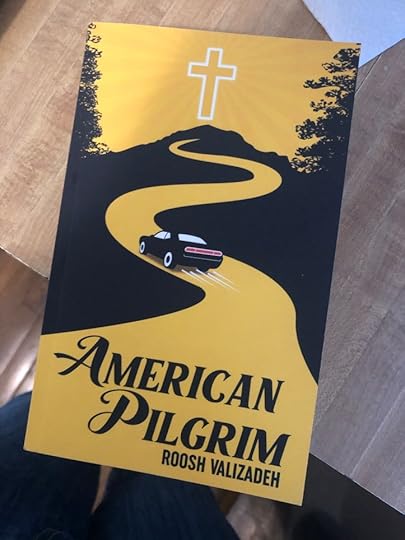 But God does. As long as our repentance is genuine. It doesn’t matter if other people think you’re insincere or doing it for attention and admiration. God knows our hearts, and will judge us accordingly. In Roosh’s case, he took a massive and voluntary financial hit by unpublishing his sex guided and alienating over half of his audience. That’s hardly something a faker would do.
But God does. As long as our repentance is genuine. It doesn’t matter if other people think you’re insincere or doing it for attention and admiration. God knows our hearts, and will judge us accordingly. In Roosh’s case, he took a massive and voluntary financial hit by unpublishing his sex guided and alienating over half of his audience. That’s hardly something a faker would do.
Remember: despite the secular consumerist American dystopia trying to tell you otherwise, sexual immorality is deadly. Not just to your body and your psyche, but to your soul. In a world where everything is commoditized and marketized and financialized and transactional, where morality is bled out of everything, it’s a hard message to remember. But remember it we must.
 St. Mary of Egypt’s experience gives us an example. She shows us the way. We don’t all have to live in the desert for decades, but on the other hand, maybe we do.
St. Mary of Egypt’s experience gives us an example. She shows us the way. We don’t all have to live in the desert for decades, but on the other hand, maybe we do.
April 16, 2021
Who Had This on Their Bingo Cards?

Sigh.

I mean, this isn’t unprecedented, just rare. I remember a killer April 1 storm eight or ten years or so ago. But today is April 16. It’s also the culmination of the Salutations to the Theotokos and the Akathist Hymn tonight.
Does this mean anything? I don’t know. But why not snag some books to make the winter weather in spring more entertaining?
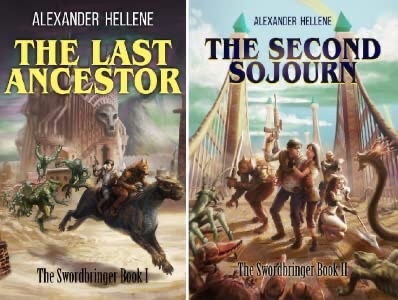
April 15, 2021
Night’s Black Agents After-Action Report #2: Get a Cluj

Our last session ended with our crew having rescued American investigative reporter Olivia Liu from the people chasing her. It wasn’t clear if they wanted her dead or alive, but the safe bet was on the former. So with Liu in the hotel we used as a safehouse thanks to Dr. Satterthwaite’s contact, we did the honorable thing with an American journalist and pumped her for information instead of “accidentally” burying her alive in the Sahara.
The Doctor handles the interrogation, providing Ms. Liu with a drink and a cigarette before reassuring her that we are not the bad guys here and that we want to get her back home safe . . . but first, she needs to talk. The pertinent highlights of what we learn from Liu are as follows:
She is a reporter from a small, independent, hard-nosed outfit in the States that focuses on the kind of old-school journalism that used to be the norm a hundred years ago or so, where journalists exposed the corruption of those in power instead of protecting those in power from the people. The stuff about Romania the Doctor found in her hotel room involved the sale of mining rights in the Carpathian Mountains to a mining firm in London. Further, going over the photographs and other things in Liu’s files, we learn that there is an excavation going on in Romania, unearthing what looks to be a medieval castle. This is where Liu had been before she was chased out of Romania. She ended up in Morocco because it was as far as her Eastern European fixer could get her. Liu’s plan was to meet up with Safet for transport to the airport, where she’d be smuggled out on a cargo plane bound for the United States.MI6 is mixed up in this somehow, with a lot of activity going on in Gibraltar.Gibraltar, huh . . . that’s where Skorpion had his contact we intended to leave Liu with. Things are getting interesting. Also, wasn’t that guy at the cafe outside of Liu’s hotel room, the one Crisp scared away last session, from MI6? His name was Harkness, by the way. That fact seems to have slipped past me last time.
Anyway, this is where the “soft” skills the Gumshoe system provides for come into play–gathering clues. I love stuff like this. I also like how, as long as the players have the skill, they can utilize them in any way they can think up. For example, with his Network skill, Skorpion calls his buddy in Gibraltar who informs us that MI6 has been using some World War II-era tunnels for something shady, and that weird signals are coming out of there. Gowen uses his hacking abilities to dig deeper into Liu’s files, and finds out that this mining company in London is owned by a shell, which is owned by a shell, and so on like nesting dolls, finally culminating in . . . a fake person in a nonexistent entity. Very strange. He also gleans from the info, thanks to his Cryptography skill, that MI6, or whoever is really pulling the strings, is sending someone after whoever it was that sent Gowen the encrypted email that got us started on this mission in the first place, so he fires off a missive telling that kindly soul to skip town.
 So Gibraltar it is! We were planning to go there next anyway, but now that we don’t need to bring Liu–which would likely put her in more danger, seeing as how MI6 is after her–we get her safely to her contact at the airport (after convincing Crisp we don’t need to kill her; he uses his high Intimidation skill to make it clear to her that if she mentions anything about us at all, we will kill her and her family), we hop a plane to the Rock. En route to the airport, the Doctor called a friend of his in London to see if it’s worth a trip back, but quickly learns that this mining company business is a road to nowhere and that a jaunt back to Old Blighty would be an utter waste of time.
So Gibraltar it is! We were planning to go there next anyway, but now that we don’t need to bring Liu–which would likely put her in more danger, seeing as how MI6 is after her–we get her safely to her contact at the airport (after convincing Crisp we don’t need to kill her; he uses his high Intimidation skill to make it clear to her that if she mentions anything about us at all, we will kill her and her family), we hop a plane to the Rock. En route to the airport, the Doctor called a friend of his in London to see if it’s worth a trip back, but quickly learns that this mining company business is a road to nowhere and that a jaunt back to Old Blighty would be an utter waste of time.
 Gibraltar
GibraltarGibraltar is where things get interesting. We leave the airport in our rental vehicle, only to be passed by a windowless van going the opposite direction. Thanks to his high Noticing skill, Crisp sees that the driver is none other than our old friend Harkness. He gives the signal for Skorpion to turn around and tail these jokers, but not too close. Luckily, thanks to a point or two of Preparedness spent, Crisp has a small homing tracker he fires onto the car from a safe distance, allowing us to get a bead on it without attracting notice.
Harkness drives into the area of the airport where private flights takeoff and land, right up to a plane, and along with five other guys begins unloading several boxes that look like they’d be full of file folders and placing them into the plane. Skorpion parks a safe distance away while the Doctor makes note of the plane’s N number. We want to know what’s in those files, and where that plane is heading, but Gowen has no time to hack into the system and the plane is revved up and ready to go. Crisp and Gowen jump out to get closer, owing to their high Infiltration skills–which they can “piggyback” by pooling points–to see if they can swipe those files or otherwise delay the flight.
“The hell with this,” is Skorpion’s reply through our earpieces. “Watch this.” He immediately calls the airport, informs them there’s a bomb somewhere either in the airport or on the plain that’ll blow in four hours, and promptly hangs up. This gives Crisp and Gowen a chance to sneak onto the plane where they see Harkness arguing with the pilot about why he can’t take off.
“Well,” Crisp says to himself, “might as well kill them all.” And since these are not fighting men, just MI6 spooks with “desk jockey” written all over them, they go down easy owing to Crisp’s high shooting skill. Shooting is also Crisp’s MOS, a term meaning Military Occupational Speciality. It’s a mechanic the Night’s Black Agents uses which essentially lets the skill a player makes their MOS always succeed once per session. The Doctor’s, for example, is Medic. Anyway, Crisp perforates these dudes while feeling perhaps maybe the faintest glimmering of a slight twinge of what could possibly be called the embryonic stages of a thing almost resembling remorse if looked at sideways, turns to Gowen, and says, “Now we can get the boxes.”
They’re able to bring four of them back, load up the idling car, and hop in right as Skorpion hightails it for the ferry in the North of Gibraltar that’ll take us to Cadiz, Spain. The plan is to drive through Europe to Romania, since there’s no point in heading to London and we think we’ve already gotten what we’d have found in the MI6 tunnels in Gibraltar. Plus, the heat is on and we really need to hightail somewhere far, far away.
Combat, so far, has not been dice-heavy, nor does it require crunching many numbers. Without having pored over the rules myself, I’m assuming that combat becomes more stat- and dice-reliant against more formidable foes, but for now I’ll take the easy kills. It takes a toll on Crisp’s stability, already low, but by praying his rosary, which is in character, he is able to restore a point.
Romania, home of beautiful mountains, Europe’s largest wilderness areas . . . and the birthplace of the vampire mythos thanks to the real-life 15th century Voivode of Wallachia, Vlad Dracul. The Doctor, with his research ability, and Gowen, with his Traffic Analysis and general computer skills, go through the files and see a lot of weird stuff–talk of research that has been going on for over a century involving–get this–vampires as deniable assets? Chatter using terms like “jacks,” “targets,” “assigns,” and “boxes.” “Boxes” is clearly code for “coffins,” while “jacks” seem to be the assets themselves. The project is called OPERATION EDOM–very Biblical, as the Doctor notes–and the dig is taking place near the cities of Cluj-Napoca and Târgu Mures . . . both in Transylvania.
 Vlad III, aka Vlad Dracula
Vlad III, aka Vlad DraculaThe Doctor notes that Edom was the name of a kingdom in the ancient Middle East. It’s the Hebrew word for “red,” so named because it was founded by Isaac’s oldest son Esau, who was born “red all over.” The Edomites claimed lineage from Esau, but what ancient Hebrew kingdoms have to do with vampires is beyond our team.

Gowen doesn’t believe the vampire stuff for a second. The rest of the team is not so sure it’s nonsense, given the weird operatives that nearly deep-sixed their past few missions. Crisp, especially, recalls tussling with some baddies who were most certainly more than human,and wants to get some answers. Ditto the Doctor and Skorpion. Gowen checks his skepticism and, like a good teammate, doesn’t make fun of the rest of crew too much.
There’s more: talk of a Monastery of Malard that a local lord demanded disband and leave sometime in the 13th century. The monks quickly left without a trace, and the monastery was buried by an earthquake soon after. Weird. All that’s known of Saint Malard is that he was the Bishop of Chartres in France, and that he attended the Council of Chalons-sur-saone in 650.
We have a ringer here when it comes to Romania, since Alexandru, who plays Ricky, aka Skorpion, is actually from Romania, but it also fits that his ex-military character would know a lot about Eastern Europe. We decide to go to Cluj-Napoca a beautiful city of some 300,000 in the Carpthian mountains, which Skorpion likens to Boulder, but traditional Eastern Orthodox European and not hippy-dippy progressive. Our cover is that we’re with NATO, seeing as how Romania is a member of that organization, and it’s easy enough to get in with our fake documents, as Romania is also an EU member state. We ended this session with Crisp and Skorpion gathering intel that the mining company, whose name we still don’t know, recently hired a lot of local toughs as security.
 Cluj-Napoca, Romania
Cluj-Napoca, RomaniaOur next stop is the dig site to see what on Earth is going on with this ancient castle some fake British mining operation that may or may not be connected with MI6 is digging up . . . and what it has to do with vampires.
Bonus style points for everyone staying in character. The Doctor can’t help but hit on Liu, albeit mildly. Gowen is always looking for the stealthy angle. Skorpion has a crazy story of a tangle in a far-off locale for nearly every occasion. Crisp wants to kill everyone. This is a fun crew to play with, and it makes me sad I’ve missed out on TTRPGs for the past 20 years. I’m really enjoying Night’s Black Agensts so far, and the Gumshoe system. Very different than anything I’ve played, very different than the typical TTRPG expectations, and yet really emphasizes the RP part incredibly well. Good times.
Hopefully next session (two Wednesdays from now) we finally get some answers.
April 13, 2021
Music Review: Rush, 2112 (1976)
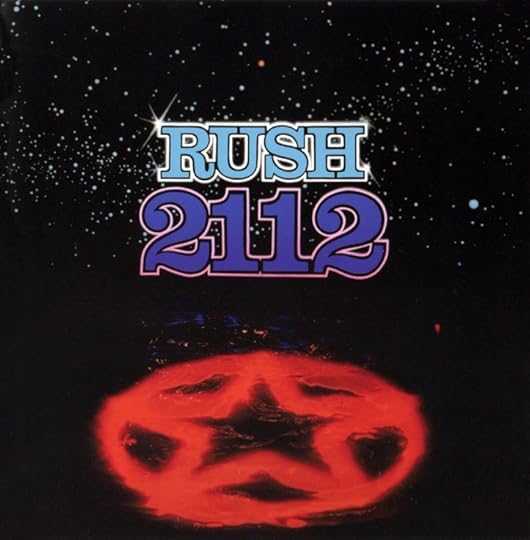
Release Date: April 1, 1976
Personnel:
Alex Lifeson – guitarsNeil Peart – percussionGeddy Lee – bass and vocalsProduced By: Rush and Terry Brown
Recorded At: Toronto Sound Studios, Toronto, Canada
Singles:The Twilight Zone”Released: August 1976“The Temples of Syrinx”
Released: May 1977
Chart Position and Awards:
Billboard Pop Albums: #94Certified GOLD by RIAA on November 16, 1977Certified PLATINUM by RIAA on February 25, 1981Certified 2X PLATINUM by RIAA on December 1, 1993Certified 3X PLATINUM by RIAA on November 17, 1995Music: Geddy Lee and Alex Lifeson. Lyrics: Neil Peart, except “Discovery” and “Presentation” — Music: Alex Lifeson. Lyrics: Neil Peart, “Lessons” — Music and Lyrics: Alex Lifeson, “Tears” — Music and Lyrics: Geddy Lee, and “Something for Nothing” – Music: Geddy Lee, Lyrics: Neil Peart.
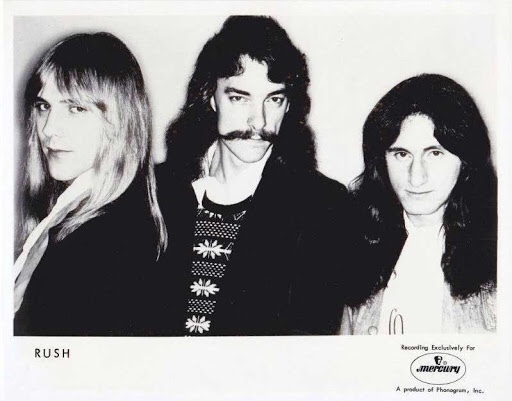
Rush took a huge gamble with 1975’s Caress of Steel, eschewing the more basic, meat-and-potatoes blues-rock style of their debut to double-down on the progressive, fantasy-based approach of songs like Fly By Night‘s “By-Tor and the Snow Dog.” It was a commercial flop compared to Fly By Night and, according to the band and the crew, with audiences as well, as the ensuing tour was nicknamed the “Down the Tubes Tour.”
Critics, of course, had a field day with Caress of Steel, notably its two lengthy prog epics, “The Necromancer” and “The Fountain of Lamneth.” Neil’s lyrics were always a source of ire among the rock cognoscenti, though Geddy’s voice bore an equal brunt of mockery. The songwriting did, of course, as well. Rush was too pretentious, too puerile, too bombastic, too outdated . . . in short, they were done. Finished. Kaput.
Polygram had written us off before 2112 had come–we’d seen their financial predictions and we weren’t even on it!
— Neil Peart, Classic Rock, October 2004
Never mind that Caress of Steel is actually a really good album, as goofy as it may be. For whatever reason, the record-buying public didn’t get it. The band was in low spirits at this time, wondering if the whole music thing was worth it. Rush’s label was also asking itself similar questions, not knowing what to do about this weird Canadian hard-rock trio with delusions of grandeur that still owed them another album. According to Rush legend, the band’s manager Ray Danniels convinced the label honchos, who wanted Rush to go back to the sound and style of the first album, that this was the band’s exact plans. I’m paraphrasing, but the agreement was this: “Don’t drop us. The boys and I have talked, and they’re going to make an album people can dance to and that will have radio singles. Catchy, short singles about girls and stuff! No more side-long fantasy prog-rock suites!” Please don’t drop us . . .”
The record label was satisfied, and leaned back, expecting the money they alloted to Rush to be used to make Rush, Part II.
Unbeknownst to Danniels, the band had been writing new material during the Caress of Steel tour, and more importantly, had been having discussions about Rush’s future. The pressure to conform, to do what others wanted, was too much to bear. Rush had always been the type of band to do it their way, and Neil Peart–who famously refused to perform on TV shows where he was required to mime, who quit well-paying gigs as a young drummer in London because he found the music puerile and offensive to his soul–seemed to fortify Alex Lifeson and Geddy Lee with his defiant attitude. Add to the fact that Neil’s admiration of author-philosopher Ayn Rand, particularly her novel The Fountainhead, had rubbed off on Alex and Geddy, and there was no way Rush would do what the bean counters demanded.
And so, keeping Danniels in the dark about what they were doing, Rush went back to Toronto Sound Studios with producer Terry Brown and . . . recorded a side-long prog-rock suite. Except this one wasn’t fantasy-based! This was sci-fi. And philosophy. Ayn Rand’s philosophy.
Just imagine how well that went over with the largely left-wing music press.

“With acknowledgement to the genius of Ayn Rand,” the liner notes said. This was enough to make Rush–including the Jewish Geddy Lee who was the scion of Polish concentration camp survivors–crypto-Nazis according to the British press. Leave aside that the band, at least Geddy and Alex, were more interested in The Fountainhead as an artistic manifesto and weren’t into the more political, libertarian, and economic arguments of Rand’s philosophy of Objectivism to the extent that Neil was, if at all.
This is all an interesting side-story to Rush’s image in the 1970s and into the 1980s, and it bled over into critical and popular perception of Rush fans. It’s unreal how critics not only viciously slagged–some may say slandered–the group, but also the people who enjoyed their music. I wrote about this extensively in Dreamers & Misfits, so if this stuff seems interesting, check the book out.
Rush’s attitude was “If we’re going to go down in flames, we’re going to go down in flames our way in a blaze of glory.” And while 2112 was a blaze of glory, it was not one that ended the band, but propelled it to great heights. The title track “2112” told the story of a far future where everything, including art and music, was controlled by a technocracy, the Priests of the Temples of Syrinx. An unnamed individual finds a guitar behind a waterfall, learns to play, and presents it to the priests, enthusiastic that his music will help the people.The Priests reject this and smash the guitar. Despondent, our hero returns home and has a dream where an Oracle shows him what the “Elder race of men” who had left the planet long ago used to be, the triumphs they created when they had unshackled freedom. This depresses our hero, who laments that he will never live in such a world, and he kills himself . . . right when the Elder Race returns to assume control of the Solar Federation’s planets and break their grip on humanity.
I lie awake, staring out at the bleakness of Megadon. City and sky become one, merging into a single plane, a vast sea of unbroken grey. The Twin Moons, just two pale orbs as they trace their way across the steely sky. I used to think I had a pretty good life here, just plugging into my machine for the day, then watching Templevision or reading a Temple Paper in the evening.
My friend Jon always said it was nicer here than under the atmospheric domes of the Outer Planets. We have had peace since 2062, when the surviving planets were banded together under the Red Star of the Solar Federation. The less fortunate gave us a few new moons.
I believed what I was told, I thought it was a good life, I thought I was happy. Then I found something that changed it all . . .
— Anonymous, 2112
Lyrically, “2112” is remarkably coherent, a bit silly but still thought-provoking and ultimately inspiring. More than that, it works on multiple levels: you can take it as a sci-fi story with a strong Randian/libertarian streak, but who are the Priests but music executives? And the unnamed protagonist . . . could he represent the band? It’s fun to think about and has spurred a lot of fan art, including a comic book you can look at here. Even more, it ushered into what Geddy Lee would call “the era of the absurdly prophetic robes,” where Rush, never a fashion-forward band, wore kimonos on stage and looked like Luke Skywalker before Star Wars was even a thing.
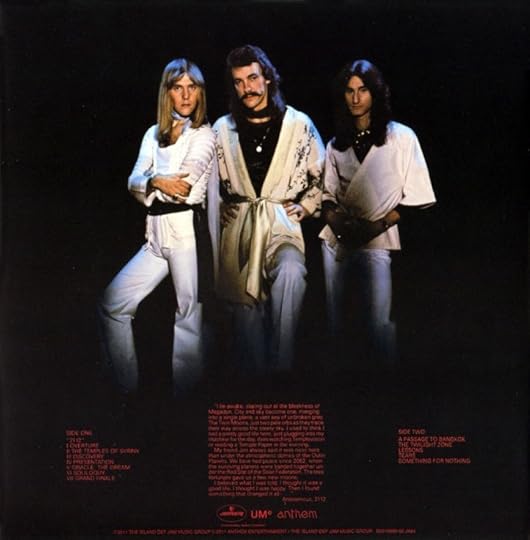
The rest of the album was rounded out with more traditional, mostly less heady fare showcasing Rush’s more straight ahead, hard-charging rock style with shorter numbers, including one song written entirely by Geddy Lee and another, uniquely, by Alex Lifeson.This was a good choice, which kept 2112 as an album from being too thematically dense though no less complex or interesting.
We don’t want to change what people think about rock & roll, we just want to show them what we think about it.
– Alex Lifeson, 1976
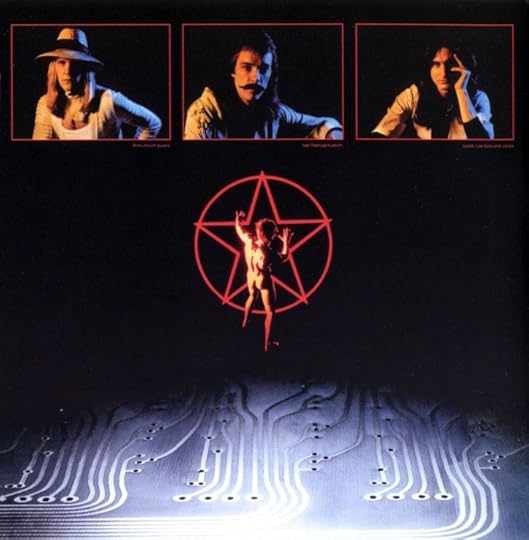
2112 proved to be Rush’s big commercial breakthrough, despite its musical centerpiece being way too long to play on the radio. It didn’t matter, as the first two movements of “2112” would get heavy airplay, and would remain concert staples long after the 1970s were in the rearview mirror. 2112 gave Rush it’s freedom, and is where the band felt like it finally found its sound, its voice. And there’s some merit to that. Much like a lot of Caress of Steel, after listening to 2112 one can’t really say Rush sounds derivative of any other band. They kind of0 have the stomp and bombast of Led Zeppelin or The Who or Black Sabbath . . . and they’re sort of lyrically and conceptually esoteric like Genesis or Jethro Tull . . . and they’re similarly virtuosic like Yes or King Crimson . . . but do they actually sound like any of those bands? Not to my ears.
All of this is to say that 2112 allowed Rush to be Rush, to go off on musical and lyrical tangents that record company execs would no longer balk at because they now knew that there was an audience hungry for this kind of music. Sci-fi and fantasy prog epics, knotty and complex songs about history and philosophy, and instrumental flights of fancy were back on the table, boys! If Rush wanted to transition from hard rock/heavy metal to progressive rock, who were the suits to judge?
Amazing what gobs and gobs of money will do to change the opinions of the powers that be. Would Any Rand approve? Probably.

In any event, how are the songs? We know that 2112 was a popular album, arguably tied with 1981’s Moving Pictures as Rush’s most popular ever. But is it any good? Refresh yourself by reading my musical rating scale here, and let’s get to the good stuff.
“2112“
I. Overture
II. The Temples of Syrinx
III. Discovery
IV. Presentation
V. Oracle: The Dream
VI. Soliloquy
VII. Grand Finale
Proggy metal heaven. “Transformational” doesn’t even begin to describe “2112.” This song is where Rush truly came into its own and presented the full potential of its vision, fully integrating complex, heavy rock with cerebral concepts into a unified whole in a way that didn’t quite work on “The Fountain of Lamneth.” “2112” is different because the musical themes are just stronger and more direct, and they hang together, whereas “The Fountain of Lamneth” had good parts that felt disjointed as pieces of a larger whole.
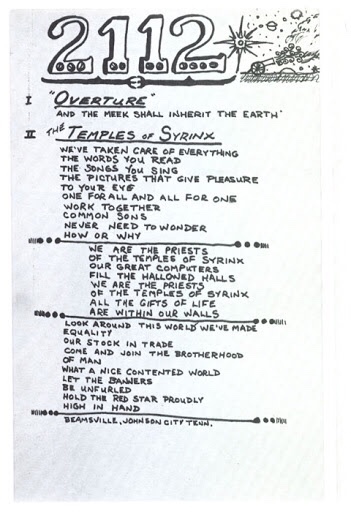
It’s interesting, because none of “2112”‘s constituent parts are particularly tricky or challenging. There are some odd time signatures and intricate drum patterns, but each section is short and lean with little instrumental lead-in or left-field turns. There are dramatic dynamic shifts between and within parts, “Overture” and “Grand Finale” are short instrumentals, and Alex gets plenty of solos in, but there is little far in any of “2112.” The reason it works, and why it struck a chord, is because the music perfectly matches the lyrics and is also incredibly intense. “2112” is a loud, aggressive, emotional, passionate, and angry song. The band’s desperation comes through loud and clear as they tear into their instruments and Geddy shrieks to the heavens. It was now or never, stardom or bust, and Rush holds nothing back here.
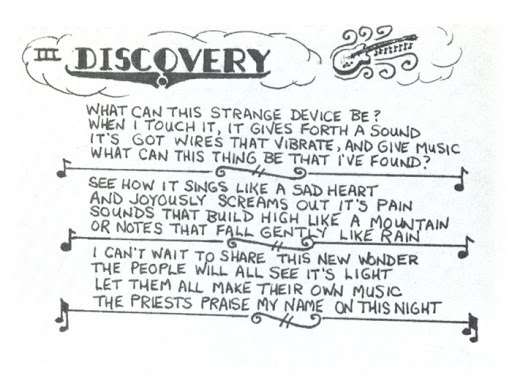
Sections flow into each other, motifs are repeated and varied, and the “Overture” is the perfect opener, combining elements of each section in sometimes obvious, sometimes subtle ways–the syncopated opening riff is “The Temples of Syrinx” all chopped up. And I’d be remiss if I failed to mention that iconic synthesizer “Whoosh” developed by artist and musician Hugh Syme that takes the listener into deep, ambient space.
I was in their studio in Toronto–my first ever visit to their legendarily private inner sanctum–and one thing led to another. Geddy and I were huddled on the floor with my Arp Odyssey synth, operating envelope filters and playing notes to produce the soundscape that opened the overture of “2112.” I then went down the hall for a few hours, and developed my Mellotron string and horn parts for Geddy’s song, “Tears.” It’s still a very fond memory.
— Hugh Syme, Classic Rock Special Edition, June 11, 2012
“2112” is a sci-fi dystopia that works on many somatic levels, as a tribute to Ayn Rand’s belief in the power of individualism over the collective, the dangers of oppressive government, and also a rather acerbic commentary on the music business.

In some ways, “2112” is the most un-Rush like of all their epics. It’s progressive mostly in scope and subject matter, but straight-up heavy metal in execution. Perhaps this juxtaposition is why the song resonated so much with fans–behind the concept there are all those scorching riffs, pummeling baselines, wailing vocals, and virtuosic drumming.
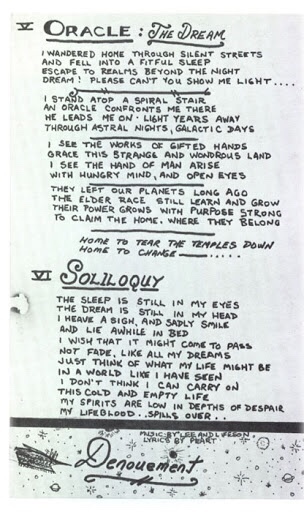
“2112” is a triumph, catchy, inventive, and iconic. It proved that Rush’s idea of prog-metal could not only work, but work well. 10 out of 10.
“A Passage to Bangkok” – Rush were never a “drug band” per se, but back in the 70s they sure enjoyed their weed, enough to write a fantastic hard-charging rocker all about the places with the best marijuana. Proving Rush were a cut above your average stoners, their journey is a metaphorical train ride through exotic locales, seeing the sights and smoking the dope. It’s both intelligent and dumb, but it doesn’t matter when you’ve got a killer groove like this. Even on a relatively conventional song like “A Passage to Bangkok,” Rush is highly orchestrated and tight, with some fleet-fingered unison runs in the chorus and an interesting, odd-time instrumental section with burbling bass and a searing solo. The spacious choruses, especially, remind me of 1980’s “Freewill.”
What’s funny, is that Rush would be unable to play “A Passage to Bangkok” live until the 1980s:
I had used the double necked Rickenbacker and Taurus bass pedals when we played “A Passage To Bangkok” live–I used to play rhythm guitar and bass pedals during Alex’s solo.
— Geddy Lee, The Guitar Magazine, November 1993
An all-time ode to toking up. 8 out of 10.
“The Twilight Zone” – It’s truly remarkable how much Rush can pack into a song that’s only a hair over three minutes long. “The Twilight Zone” is a fantastic, largely acoustic driven moody piece that alternates between dramatic harmonized electric guitars, a bouncy verse, and an introspective chorus with a characteristic, angular riff. Alex plays a very soulful solo at the end, evoking feelings of a smoky, dimly lit club where not all is as it seems. The song demonstrates the band’s growing ability to toss in musical twists and turns that transition seamlessly.
The quickest ever was “The Twilight Zone” from our 2112 album. That was written and recorded in one day.
— Neil Peart, “Stories From Signals,” Signals Tourbook
This is the kind a song that would’ve tripped the band up just a year prior, but here they pull it off flawlessly. Lyrically, “The Twilight Zone” is part of an endearing Rush tradition where Neil Peart thinks something is cool, so he writes a song about it. Here, the band were fans of the old Twilight Zone TV show, so they wrote a song about it, with each stanza inspired by an episode. Hey, why not? There are far worse things to write a song about. 8 out of 10.

“Lessons” – Fun, sunny acoustic guitar driven pop. It gets harder edged in the chorus, and I like the way the guitar line mimics Geddy’s vocal melody. Excellent, John Entwistle-inspired bass playing in the chorus. The way he and Neil play together is telepathic. I think this is the last song Alex Lifeson wrote lyrics for, and they’re perfectly fine, a rumination on how the youth never realized their elders had a point until they grow up. A good pop song that would’ve been right at home on Fly By Night–catchy and upbeat and doesn’t overstay its welcome. 7 out of 10.
“Tears” – A somber, delicate ballad that shows a vastly different side of Rush, including some, quite honestly, lovely singing by Geddy as he tells a tale of disaffected lovers. It’s one of the few lyrics he’d pen post-Neil joining the band, and they’re quite good. Very understated playing from all three members, and interestingly Rush cover artist Hugh Syme provides the Mellotron, prefiguring a lot of Rush’s later experiments with keyboards and expanded instrumentation that would really begin to grow on their next studio album. In fact, “Tears” presages Rush’s tender, more restrained side that we’ll hear on songs like “Different Strings,” “Losing It,” “Resist,” and “The Garden.” Though it borders on schmaltzy at times, “Tears” shows Rush progressing, and for that I have to give it credit as an important, underrated milestone in the band’s development. 8 out of 10.
“Something for Nothing” – This is the archetypical 1970s Rush rock song, the Platonic ideal of Rush. If someone asked what Rush’s 70s sound was all about, you’d play them this song. All of the elements are there: the band fires on all cylinders and plays to their musical stereotypes: A somber, finger-picked intro soon gives way to an up-tempo surge, and we’re off to the races. Its classic jittery, hyper, frenetic Rush action. The band sounds like a live wire ready to explode, Geddy is wailing like a banshee while playing galloping, finger-busting bass fills, Alex shreds on the guitar, and Neil plays those endless tom fills air drummers salivate over.
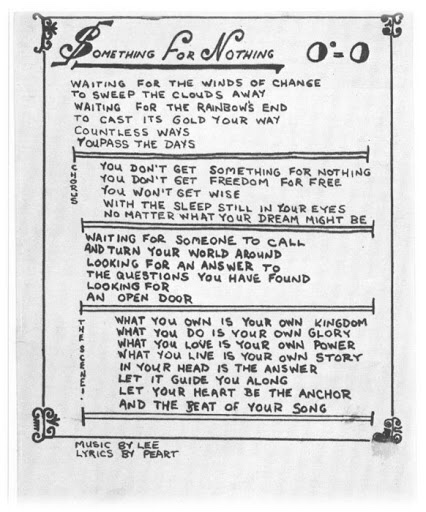
Neil’s objectivist lyrics, about the power of the individual to impose his will on the world, alone, also speak to this song’s status as the ur-Rush tune. It’s all here.
All those paeans to American restlessness and the American road carried a tinge of wistfulness, an acknowledgment of the hardships of the vagrant life, the notion that wanderlust could be involuntary, exile as much as freedom, and indeed, the understanding that freedom wasn’t free. In the mid-’70s, the band was driving to a show in downtown Los Angeles, at the Shrine Auditorium, and I noticed some graffiti splattered across a wall: “Freedom isn’t free,” and I adapted that for a song on 2112, “Something for Nothing.”
— Neil Peart, Traveling Music
If your ambivalence about Roche or I’ve never heard them before, this song will either make you a rabid fan or you will load every second of it. Eight out of 10. A kick ass way to close a kick ass album
Final Rating: 49/60 = .8167 x 100 = 81.67
Fans might be surprised at the relatively low score here–how is 2112 only slightly better than Caress of Steel, right? Because it is only slightly better! “2112” is a better epic than “The Fountain of Lamneth,” but otherwise Caress of Steel was pretty strong and tight. 2112 tweaked Rush’s sound and sanded down the awkward edges into something diamond-hard. In my opinion, this is fair and objective, and anyway, Rush’s winning streak wouldn’t begin in earnest until their next album, A Farewell to Kings.

Critical reception to 2112 was generally favorable, with critics appreciating Rush’s ability to pull off such an ambitious piece, as well as the band’s musicianship and furious live performances.
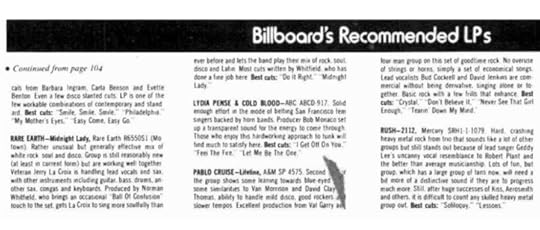
My favorite is this piece from Circus that not only digs a bit deeper into the concept of “2112,” but recognizes that for all of their prog tendencies, Rush never strays far from their hard-rock roots.


Other critics damned with faint praise–see this funny but obnoxious review in Creem–though the Canadian Composer seemed genuine when it stated that “some pieces can be enjoyed without earplugs!”

The tour was quite successful as well, with Rush really winning over American audiences. Whether headlining or opening, Rush played to enthusiastic crowds who loved the new stuff, and the album kept selling and selling. It was a major turning point in Rush’s career, a gamble that this time paid off, a victory that saved them from being a minor footnote in the world of rock and roll.
Here’s a show from May 30, 1976, from Springfield, IL:

“2112” really rocked live, though “Discovery” and “Oracle: The Dream” were cut to keep Rush’s set tight and allow them to squeeze in a few more songs–the entire suite would not be played until the 1996-1997 Test for Echo tour.
So what was next for Rush? Where would they go from here? Important questions, and the band never stopped writing whether at home or on the road, and the “2112” tour went on, but there was another item to check off the “Popular and Successful Rock Band” list. After all, what self-respecting act didn’t have a live album?
THE COVER
Designed by: Hugh Syme
Hugh Syme returns as cover artists, gracing 2112 with a suitably celestial cover. The band name and album title look great against a street background, with an ominous red star reflected on the water. It really works, evoking a feeling of mystical, interstellar menace.

It’s good! It’s memorable! It’s minimalistic! I like it! Let’s hear what Hugh has to say. From Ultimate Classic Rock:
Though Syme acknowledges it’s become a “marquee” Rush cover, he deflects praise for his own 2112 contribution. “If you ask me, as an artist or an art director, how I feel about the cover, I look back on it as being pretty formative, pretty primitive,” he told UCR. “But I realize that I somehow intuitively managed to tap into my conversations with [drummer and lyricist] Neil [Peart] about the arc of his story: the content of the hero confronting the evil red star and the Solar Federation.”
More:
“The tail wags the dog,” says Hugh Syme, reflecting on his “marquee” cover for Rush’s 1976 LP 2112.
That’s a reliable refrain from the band’s longtime art director. As he notes, it’s a fool’s errand predicting which images will become iconic — time alone can tell that tale. And in this case, he modestly deflects praise for the sleeve, instead redirecting credit to the prog-rock trio’s ambitious fourth album — particularly “2112,” the side-long, 20-minute sci-fi epic exploring themes of liberation and oppression.
“If you ask me, as an artist or an art director, how I feel about the cover, I look back on it as being pretty formative, pretty primitive,” Syme tells UCR. “But I realize that I somehow intuitively managed to tap into my conversations with [drummer-lyricist] Neil [Peart] about the arc of his story: the content of the hero confronting the evil red star and the Solar Federation.”
The cover features the glowing star and a galactic backdrop, with the band name and album title hovering above. Ironically, the signature piece is found inside the gatefold, where the “Starman” character — depicted by Syme’s “bare-assed” friend Bobby King — stands defiantly against the looming star. (King became a semi-fixture of Rush covers: “He showed up again in the wings of Exit … Stage Left, and he was also the prime mover — no pun intended — for the Moving Pictures cover,” Syme says. “I made good use of his good will … and his cheap modeling fees.”)
Syme notes that he “didn’t ignore” Peart’s lyrical concept with the cover, but the end product wound up giving more real estate to text. “It’s one of the few covers I’d call a ‘marquee,’ where the title occupies most of the space,” he says. “Management loved it for that very reason. It’s as my grade seven art teacher used to say: ‘Fill the space.'”
Even though Syme doesn’t consider 2112 one of his definitive works, it remains one of the band’s most famous: The “Starman” later appeared on several other Rush covers: It hovers above Peart’s drum kit on their 1976 live album, All the World’s a Stage, and if you squint, you’ll see it displayed in one of the paintings hauled around on 1981’s Moving Pictures. It’s essentially a band logo — and Syme says the merchandising numbers prove its enduring popularity.
“It certainly found its place in history because of the music,” he says. “It’s recognizable in its association with that lovely album. I think the music plays heavily into any merits that people attribute to the art itself.”
“My favorite [comparison] is the Blind Faith cover with the crudely cut out girl with the art deco hood ornament airplane thingy [on their self-titled 1969 album],” he adds. “It’s a pretty primitive technical feat, but a memorable and impactful cover. I think certain elements in art find their place in history — in this case, it’s more born of the music, and the cover follows suit.”
I’m with Syme, and I think many fans conflate the Starman logo which is inside the album for the album cover itself.

If the Starman was on the cover, the rating would be a 10, no questions asked, since it’s a perfect visual representation of what the song “2112” is about. Maybe the band or the label balked at having a naked man on the cover. Oh well. What we got is still pristine and iconic in a cold, crystalline sort way. It fits the mood of “2112” and lets the listener know he’s in for some sci-fi goodness, but it just doesn’t set the table as visually, and viscerally, as the Starman logo which, I reiterate, is not the album cover.
Cover Rating: 9
Thanks to Cygnusx-1.net and 2112.net for the scans.
If you enjoyed this review, check out Dreamers & Misfits, my book all about the international, intergenerational phenomenon that is Rush fandom. Buy it here!

April 12, 2021
The Things We Put Up With

Money does kind of ruin culture.
Let me explain.
If something makes money reliably, we see more of it. That something makes money is usually an indication of quality: if car manufacturers didn’t make money, they’d stop making cars, after all. Or they’d stop with certain features or models. There are reasons you don’t see some cars that you used to anymore: they’re not profitable. And if they’re not profitable, that usually means people aren’t buying them, and the company that insists on producing them will soon be out of business.
A lot of this sounds better and works cleaner in theory than practice, but with tangible, physical good, the praxis tends to play out more or less as expected. I think cars are a good example of this–enough people bought Teslas in the early stages in steadily increasing numbers to make Elon Musk eat the loss and keep refining his product instead of pulling the plug on the whole electric car endeavor. Products that survive are good enough at their function–perhaps great–to survive.
People still play Fender guitars and basses for a reason: they sound, feel, and look good. Ditto the Gibson Les Paul. I’m sure you can think of other examples of timeless classics that deserve their reputation and longevity. The great thing about such longevity is that the makers have the financial insulation to innovate both radically and around the edges, pushing their technology forward while still performing their core competence well.
These principles seem to work everywhere except in consumer technology and entertainment. I’ll stick to the latter, though, since it is more in my wheelhouse.
We see this hundreds of times in books, music, movies, video games, and TV shows: something makes money, so every other company races to get a similar product to market to snap up the dollars that are waiting there. Remember the glut of Young Adult novels, particularly dystopias, once The Hunger Games became a big hit? How about vampire-themed urban fantasy/romance after Twilight? Go back further and you’ll see kid-oriented fantasy a la Harry Potter everywhere.
Music is another obvious example where we see endless bands of the same genre pop up at the same time. It didn’t just start with rap-rock and nu-metal, or emo, or even grunge. It goes back to the days of the British Invasion where marginal bands that sounded a little bit like the Beatles or the Rolling Stones were given deals and foisted onto the public. Some, like the Kinks and the Who, were more than worthy of the attention they never would have gotten otherwise, but plenty of others are not remembered because they weren’t that great.
Movies are a similarly good example. It’s been all superhero stuff from 2008 until now, and will likely continue despite the diminishing quality. And check out video games: endless first-person shooters and hand-holding “open world” RPGs that don’t do anything particularly well, in addition to remakes and remasters of past glories, not to mention sequel after sequel that really don’t offer anything new.
So what’s the difference between pop culture and the car example I used earlier? It’s that people still keep paying for entertainment.
It’s like a drug. It’s like, if people don’t get the latest version of the thing they already have, they’ll go bonkers and won’t know what to do with themselves. I can’t understand it, especially among people who complain about it. If you like what’s coming out, great! Keep buying it and I sincerely hope you enjoy yourself, and that is said with no sarcasm whatsoever. But if you’re going to complain about Laser Sword Movie Franchise or Hooded Assassin Video Game Franchise, but keep buying it and talking about it, what’s the rationale behind that?
The rules of economic behavior break down when it comes to pop culture, and I think I know why: unlike a car or a toaster oven or a water heater, entertainment is psychologically designed to tickle and caress the pleasure centers of the consumers’ brain. Further, art is a powerful thing that will affect you mentally, spiritually, and even physically . . . whether or not it’s good and whether or not you like it.
Art is a craft, but it has an element above and beyond that recliner in your living room or the toothbrush you scrub your pearly whites with in the morning and at night (you are brushing twice a day, aren’t you?). Art is weaponized against populations as a form of propaganda, the most effective form, in fact. If you can get people singing along to a catchy pop song with reprehensible, subversive, degenerate lyrics, there’s no telling what else they’ll accept because they’re already literally mouthing your message. If people watch movies filled with violence, depravity, sex, and other dyscivic messaging–and pay money for the privilege–you have them by the proverbial short and curlies, ready for further programming.
Art is power. Those who produce mass art for mass consumption know this. They know you’ll continue paying for it even if you think it’s all garbage. How many people have actually canceled all streaming services, cable, and have stopped watching professional sports due to “wokeness”? I doubt many. “Get woke, go broke” is, as has been said, the biggest cope around because not only are the gigantic entertainment conglomerates propped up by endlessly deep pockets, not only is actually making money not their chief concern, they also are full of talented people, like it or not, who often enough, whether consciously or by accident, produce fantastic product that many use to justify their continued support.
But that’s like saying, “My car’s brakes work 50 percent of the time, and when they work they work great, so I might as well keep this car.”
 Pictured: Your favorite franchise. Why do you pay for this?
Pictured: Your favorite franchise. Why do you pay for this?If audiences started behaving the way economic theory predicts they should, the whole edifice would crumble. I have no practical guide as to how to make this happen. I just want to get people thinking about this phenomenon.
April 8, 2021
Night’s Black Agents After-Action Report #1: A Passage to Marrakesh

For the first time in about 20 years, I’m in a table-top RPG game. A small crew of guys and I are playing a game called Night’s Black Agents over Discord. This is a game based on the rules of Gumshoe, a game I’ve never played, and it involves superspy black-ops types trying to uncover a vampire conspiracy in Europe. And so, like how my friend BDubs does with the RPG sessions he runs, here’s the first Night’s Black Agents after-action report.
Shane is the Director (GM). Our crew consists of the following:
Jonathan Crisp, played by Oghma: A wetworker, former CIA trained killer who is brutal yet emotionally fragile.Ricky, aka Skorpion, played by Alexandru Constantin: A former stuntman, our trick driver, and a smuggler. James Gowen, played by Ryan K.: Our black bagger, ace hacker, and a guy who knows how to get the information we need.Terrence Satterthwaite, played by me: Scion of English nobility, an expert doctor, trained swordfighter, and ladykiller. He’s Dr. James Bond, vampire slayer.Night’s Black Agents is a very streamlined RPG system, and character creation is fun, with just enough complexity to make it interesting but not so simplistic as to be boring. Your choices of skills matter, but they won’t make-or-break your game before you even play; at least, that’s the impression I’ve gotten after our first session. You can choose a Background if you’d like, e.g., medic, wet worker, driver, and so on, each with a package of Investigative and General skills. These skills that come with a background package deduct from your pool of Investigative and General skill points. Each character, regardless of Background, if chosen, or anything else, gets a few basic minimums in certain skills, as well as in Health (typical RPG-style hit points) and Stability (think mental hit points). The remaining points can then be used to bolster these skills, or add new ones. Skills come in two flavors:
Investigative: These are things like research, languages, art history, flirting, streetwise, and so on. Since a large part of Night’s Black Agents involves acquiring clues and information, many of these skills are used automatically when declared by the player or the Director, no rolls required. One point in an Investigative skill makes you a trained expert at it, and you’ll get the clue. Additional points mean you might get more clues, or you can spend your point(s) to uncover more and more secrets and information. Don’t worry, point refresh. Some of these skills are very cool. Dr. Satterthwaite, as befitting a privileged English upper-crust individual, has a diverse and, hopefully, helpful skillset of things like multiple languages, flirting, reassurance, high society, flattery, art history, history, astronomy, and architecture, among others. General: Stuff you do; think active skills. Here is where your weapons proficiencies come in, as well as things like hand-to-hand, driving, athletics, explosives, concealment, hacking, and so on. These you do have to roll to accomplish. You can pump tons of points into these, with eight and above representing absolute badassery. However, Night’s Black Agents only uses one six-sided die, so there’s a challenge number you must meet, depending on the difficulty of the task. A difficulty of four, for example, means you need to roll a four or above. What you can do is spend points to add to your roll, meaning if you spend three points of the skill in question, you’ll automatically pass the challenge, whereas spending a point or two increases your chances, as long as you don’t roll a one. It’s a very fun, easy-to-grasp system that makes for quick play.There are other rules I don’t quite understand yet, since I haven’t read the book, but they’ll come about naturally.
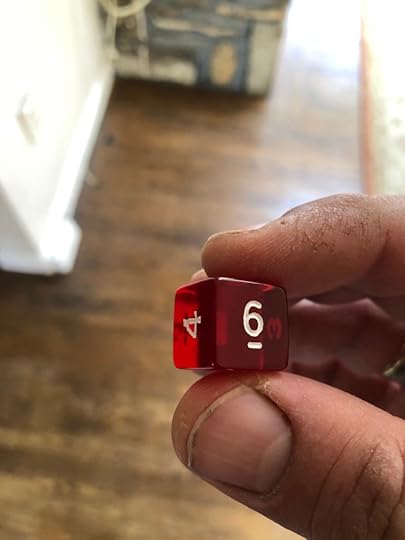 You also pick your character’s three sources of stability–a symbol, solace, and a place–which not only affect your character’s well-being, but can come into play in interesting ways. Lastly, there is your character’s drive, their motivation for doing what they do. This adds verisimilitude, and as always, the game doesn’t bind you with rigid “class” choices.
You also pick your character’s three sources of stability–a symbol, solace, and a place–which not only affect your character’s well-being, but can come into play in interesting ways. Lastly, there is your character’s drive, their motivation for doing what they do. This adds verisimilitude, and as always, the game doesn’t bind you with rigid “class” choices.
The game takes its cues from Bram Stoker’s Dracula, as well as other vampire novels and movies, as well as films and TV shows about spies, action, and adventure. Taken, The Bourne Identity, Burn Notice, James Bond, anything you can think of. It’s more of a “story game” where the players sort of do what they like in the confines of the scenario the Director sets up, and can accomplish various tasks as they see fit given their unique skills and how the team meshes together.

Enough of this. On to the report.
Our small crew has worked together before, and has had some scary run-ins that have nearly derailed past missions. Who, or what, was responsible for those, we don’t know. But one day James received an encrypted email package of information with a mission, offering good pay . . . as well as the possibility of some answers. Who hired us is unknown right now, but we’ve been tasked to find American investigative journalist Olivia Liu before someone else does. Why they want her is also unknown, but the promise of answers to the forces that had menaced our previous missions is too good to pass up, even more appealing than the money.
Liu was last seen in Marrakesh, Morocco. Skorpion and Crisp were able to lean on some contacts of theres to get us to Marrakesh and, more importantly, get us kitted out with weapons, supplies, and a sweet air-conditioned bulletproof SUV. Skorpion was able to get us some forged Al-Jazeera press passes. Dr. Satterthwaite used one of his contacts to set up a safe house at a local hotel he’s familiar with. Gowan noticed that the email was sent using civilian encryption–good, but not the best. The plot thickened.

We landed in Marrakesh and milled about the market. Crisp, who along with the Doctor speaks Arabic, was able to use his streetwise skill to learn from some locals that the American journalist was staying at a hotel in Jemaa el-Fnaa, the main market square and a touristy area. The team also learned that, while locals would be used as eyes and ears of whomever was after Liu, a foreigner would be the muscle who would actually do the kidnapping. We headed over there to case the place, a former manor turned into a relatively dumpy hotel.
There were some suspicious characters around the hotel, two locals on motorcycles across the street eyeing the hotel with a third, empty motorcycle near them, and an out-of-place, well-dressed white man sitting at a cafe . . . all gleaned thanks to Gowen and Crisp’s urban survival and noticing skills. The plan was this: Crisp, Gowen, and Skorpion would neutralize the lookouts one way or the other while the Doctor sneaked into the hotel, found Liu, and brought her to safety. Easy, right? For this crew, it actually was.
Crisp sauntered over to the white man at the cafe, took one bullet out of his pistol’s magazine, and slapped it on the table. “The next one’s going in your head. You’d best step off,” he said, or something to that effect. His relatively high intimidation skill made the guy nearly soil himself. He also revealed he was working for MI6. “You shouldn’t be here,” Crisp intoned. “Leave your radio and earpiece.” The Englishman did so, not wanting any trouble. Was he a weenie, or smart? Will he be back? We’ll see. My money is on smart weenie.
The motorcycle guys pose a different challenge. Do we intimidate, attack, or distract? Skorpion opts for the latter, imitating the most obnoxious American partying tourist he can and inquiring where he can get some sweet hashish, man . . . all while Gowen swipe their keys. This lets the Doctor slip into the hotel, but he spends a few points of infiltration anyway to help him get to Liu’s room unnoticed. Once in the hotel, Skorpion drops the pretense and starts insulting the men, who keep their cool because, as we’ve been informed, the police in Marrakesh do not tolerate any disruptions to the city’s vital tourism industry.
The Doctor picked the lock to Liu’s room and finds the roach-infested pit empty. It looks like the American reporter left in a hurry, but thanks to the Doctor’s streetwise skill, he finds a hastily scribbled note with the name Hasan Safet, a contact the Doctor knows from previous trips here. There’s also a big file folder full of interesting, cryptic, and creepy stuff–travel itineraries to Romania among them. The Doctor is a trained researcher, and he’s able to quickly find some more interesting information, including talk about vampires, of all things. There’s something called the Harkness file, something like that; I can’t remember but it’s something that will require further research when there’s time.

A sound at the door forces the Doctor to hide. Another Moroccan youth come in, but he’s ambushed by the Doctor with a knife to the throat and orders not to move. The Doctor searches the kid and finds motorcycle keys, a knife, and a small radio. He shepherds the kid outside where he’s interrogated by the rest of the team in a very surreptitious manner. He claims to know little, and along with the other two motorcycle riders was working with the Englishman–that’s where his radio went to.
The Doctor uses his reassurance skill to make the kid understand if he lays low and keeps his mouth shut, he won’t be hurt. The crew piles into the SUV and Skorpion rides in the direction of Safet’s place, hoping the team can intercept Liu before the bad guys do . . . whoever they are. I remember at one point Skorpion used his cop talk skill to pump a local officer of the law for info while using the fake press pass, and a $100 bill, to glean a sighting of Liu and her general direction.
Thanks to Skorpion’s excellent driving, and judicious application of skill points, we win the chase–a successive series of challenge rolls between Skorpion and the bad guys, with some pooled points the rest of us can throw in–getting through the narrow, crowded streets, human barricades, and other traffic, closing the distance first so Crisp can jump out and force Liu into the van. Skorpion then pulls some more epic driving maneuvers to lose our tail and get to our safe house, Gowen and the Doctor reassuring Liu on the way.
We made it this far without attracting any heat from the local police, or even getting shot at, but we did see some out-of-place vehicles taking off, so the chances are that trouble will be finding us very, very soon. Our session ended because it was late and we’re all too old to be staying up wicked late playing an RPG.
On the whole, I like it! It’s fun, doesn’t require tons of number-crunching, and can easily be played over a Discord chat. It’s a resource-management game, what with the spending of skill points, and while we didn’t have any combats yet, so far I’m a fan of the Gumshoe system. Apparently there are tons of setting books for it, but I find it works very well for this type of spy-thriller scenario which makes sense given Night’s Black Agents‘ pedigree as an offshoot of Gumshoe.
Our next step will, obviously, be to debrief Liu, find out who is after her and why, and get out of Morocco and to some of Skorpion’s old SAS pals in Gibraltar alive.
I like how each character type gets their chance to shine. And so far, the team has worked well together–remember, according to the story we are all old friends and teammates.
I hope you enjoyed this type of post, and I’m psyched for next Wednesday’s session. I’d forgotten how much fun TTRPGs can be.
Not a TTRPG, but The Swordbringer would make an excellent setting: Dog-men Warriors! Freaky alien monsters! High technology meets sword and planet! Gunfights and swordplay on a faraway, hostile alien world! The adventures write themselves. Check out the books here.

April 6, 2021
Don’t Go Broke, Don’t End Up in Jail, and Don’t Die
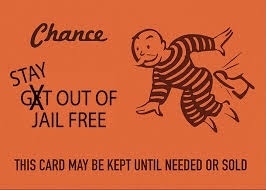
If there ever was a good time to keep your nose clean and keep your head down, it is now. We aren’t entering into troubled times: we’re in the thick of them. Rough waters ahead, girls and boys. Our jobs now, nay, our duties, are to take care of our families and our communities as best we can. And the best ways to do this are to STAY ALIVE, STAY HEALTHY, and STAY OUT OF JAIL.
It galls, believe me. I get it. We all want to be the brave crusader standing up for this lofty principle or that, but you have to understand that those days are gone. Unless you toe the line set before us by the mass media, the government, the journalistic profession, the educational establishment, and big business–all different fingers clenching into the same iron fist–you will be put down ruthlessly and harshly.
The truth, though, is that every single successful mass movement, at least in America, had huge amount of official power, influence, and money behind it. Ask yourself this: why are certain movements allowed to flourish by the authorities, while others are suppressed and ground down into the dust? It’s because the ones that succeed serve our oligarch’s interests.
None of these were organic, and the ones that are, get squashed and receive no official support. In fact, every single institution is arrayed against them. Movements like these are the true danger to the pre-existing power structure.
We have a multi-tiered legal system–note, not a justice system–here in the United States. Punishments will be meted out according to who and what you are, and what you did to whom. In the Soviet Union, it was all depending on your class. Here in the Land of the Free, it’s more based on other, more superficial and visual characteristics, as well as what your ancestors may or may not have done to the ancestors of other people. It’s evil and insane, but the sad fact is that the evil and insane are far more willing to fight and die for their evil insanity than normal people are for good, true, and noble ideals.
There are faint glimmers of hope. The Polish church in England who successfully fought off the cops trying to end their Easter services was a good morale booster. But those congregants must still watch themselves, since retaliation will likely come their way. The State never forgets those who embarrass it or give it a bloody nose.
YOU WILL BE TESTED. It might be something small, like getting you to parrot an idea you don’t really believe in. It might be large, like saying you can’t go to church anymore. But it will happen.
YOU WILL BE PUNISHED. It might be relatively tiny, or it might involve a small, barred room and a giant individual named Tiny who really wants to be your best friend. Chances are, it’ll involve removal from your job or other means of financial support and ability to even use things like banks, but it will happen.
The best we can do is mitigate our risk and attempt to avoid ruinous punishment at all costs.
GET HEALTHY. Lose weight, hit the gym, stop smoking and drinking so much, and so on. One easy way to avoid the system is to not need to be shoved into it in the first place.BUILD COMMUNITY. Whether online or, preferably, in real life, you need a support network of the like-minded who can provide moral support and give aid when required. Help others and they will help you. It’s impossible to build anything all alone despite what these “rugged individualists” might tell you (also: look at what lasting things people like this have built–oh right, you can’t because there isn’t anything). Get over your hatred of being in groups and “collectivism.” Start going to church. Put out an ad in your town about some shared interest and try to build a community that way. It’s never been easier to connect. A lot of times when one person starts something, and a second person joins, it snowballs from there. Do it!EXPLORE ALTERNATIVES. It’s already happening that people are using banks and payment processors and technology from China, Russia, and other parts of the world in order to have more freedom of speech and freedom of commerce than they can from ostensibly American corporations, financial institutions, and technology providers. Divest yourselves as much as possible.STOP GIVING MONEY TO PEOPLE WHO HATE YOU. Not much else needs to be said about this, but if you need to learn more, read this.SAVE MONEY. This might mean investing in precious metals, stocks, cryptocurrency, real estate, or all of the above. Or it might just involve squirreling away as much money as possible. All are valid. DON’T BE A HERO. Stay out of the streets. Don’t “counterprotest” a protest. Don’t try to stop rioting and looting. You are a second-class citizen and will be treated as such. And yes, you will he killed without hesitation, and nothing will happen to those who kill you. Know this, internalize this, and deal with the injustice of it all. Remember, no one in power gives a rat’s ass about the Constitution, your rights as a citizen, or an impartial reading and application of the laws of the land. The Founders are dead and literally nobody who matters cares about what they had to say or what they thought about government and its relationship to the people. The bad guys won. We are living in occupied territory. It sounds dramatic, but this is how you have to think if you want to survive and thrive.There are opportunities to succeed. You just need to be strategic and smart about it. It’s easier said than done, but you can:
Start an online business. It’s easier said than done, but you can start small and try providing some service to fill a need you see. Maybe it’ll never replace your day job, but it sure can supplement it.Get into the arts. Music, movies, books, whatever. Several hundred million people are thirsty for alternatives to the slop thrown before them. Run for office in your town, or join some other board or committee. Want to get involved? Forget the national, or even the state level. Those formerly august halls of power are run by greed, corruption, and creepy perverts who only allow the compromised who play along to make a career out of it. Stick to local if you want to make a difference and keep your soul.Join a church. I can’t urge this enough. Find a good, non-converged church–Orthodox and Catholic churches are good starts, but there are others–and go. Pray. Read Scripture. Maybe you don’t believe in the supernatural, but I guarantee if you’re on this side of the divide, who are not happy with how things are going, you probably have way more in common with Christians than you do with nearly anyone else.You will do your family and community no good broke, in jail, or dead.
I’m doing my part–my books are available here.

April 5, 2021
I’m on Two Guys Talking Rush

Like I hinted at in my last email–and if you’re not signed up to the list, you really should, since you’ll also get a FREE unpublished novel–I’m on another Rush podcast: this time it’s Two Guy Talking Rush with music writers Daniel Bukszpan and John Kane!
Daniel and John reached out to me late last year, and scheduled a taping in February/March. I admit that I put it on my calendar and then sort of forgot about it until after the New Year when things quieted down a bit, and when Daniel got in touch with me a few weeks before our taping, I was psyched. It’s always a good opportunity to talk Rush with other fans. Our conversation was about Dreamers & Misfits and how Rush was able to create such a strong bond with fans, and why it has been so powerful and long-lasting.
If you’re a fan of the band, Two Guys Talking Rush should absolutely be in your rotation. They have a bunch of episodes with great guests, and Daniel and John are just good guys and talented writers. I enjoyed talking to them a whole lot, and I hope you enjoy listening to us chat about the greatest band in the universe.
Check it out here, and if you’re so inclined, snag a copy of Dreamers & Misfits here and leave a review–we’re up to 30 now, and a four-and-a-half-star rating. Would sure love to get that up to five stars . . .
Take care everyone, and as always thank you for your continued support.
















